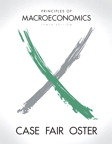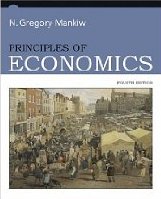No |
Day |
Book
Chapter |
Topics |
Further
material |
1 |
Wed
29 June |
(Mankiw chap. 1) |
Introduction
and “10 Principles of Economics”
-
Basic Questions: Why Economics?
-> Basic
Concepts of Economics
|
|
2 |
Thu
30 |
(Mankiw chap. 1) |
Introduction: Basic
problems; economic systems |
- Hierarchy
of goals in market economies
- "Wall Street" (1987) @ Wikipedia; "Greed
is good" speech on Youtube or a
commented version with highlighted texts. |
3 |
Tue
5 July |
|
Teams' Presentation
about Mankiws
"Ten Principles of Economics"
PART II Concepts
and Problems in Macroeconomics
5 Introduction
to Macroeconomics |
Please use the
online resources, tests and case studies on the book webpage (see
above) |
4 |
Wed
6 |
|
5 Introduction
to Macroeconomics
6 Measuring
National Output and National Income |
Debate
in the Economist about GDP as a measure of welfare.
|
5 |
Thu
7 |
|
6 Measuring
National Output and National Income
7 Unemployment,
Inflation, and Long-Run Growth
(discussed up to the definition of the labor force (participation rate)
and the unemployment rate, page 130, slide 8) |
|
6 |
Mon
11
(room A 123) |
Test 1 |
- Brief repetition
and your questions
- Test
1 with 75 questions (up to chapter 7 - only
rates, see above) |
results
by ID numbers (available after class) |
7 |
Tue 12
(room
A 123) |
|
(brief
review of test 1)
7 Unemployment,
Inflation, and Long-Run Growth
PART III The Core of Macroeconomic Theory
8 Aggregate
Expenditure and Equilibrium Output |
Annenberg
Video @ learners.org:
5. John Maynard Keynes |
8 |
Wed 13
(room
A 123 pc lab) |
|
8 Aggregate
Expenditure and Equilibrium Output
Teamwork in the pc lab (see tasks in table below) -> |
Some sources
of data and information:
o U.S. Department of Commerce: www.commerce.gov
o Bureau of Economic Analysis: www.bea.gov
o Bureau of Labor Statistics: www.bls.gov
o Federal Reserve System: www.federalreserve.gov
o The World Factbook (CIA): www.cia.gov/library/publications/the-world-factbook
o For data on Europe, visit europa.eu (European
Union home page) and
o the European Central Bank home page on www.ecb.int.
o International sources include the
International Monetary Fund www.imf.org
and the World Bank www.worldbank.org
|
9 |
Thu 14
(room A 123) |
|
9 The
Government and Fiscal Policy
|
+ Short presentations
of the results of yesterdays teamworks |
10 |
Mon
18
back in room
A 110 |
|
9 The
Government and Fiscal Policy
|
Annenberg
Video @ learners.org:
5. John Maynard Keynes |
11 |
Tue 19 |
|
Final
discussion of:
9 The
Government and Fiscal Policy
(current situation and exercises)
|
(some exercises
in class: Class_exercises_chapters_7and9.doc
and answers to index/inflation questions in Class_exercises_chapters_7and9.xlsx) |
12 |
Wed 20 |
Test 2 |
- Brief repetition
and your questions
- Test
2 with 75 questions (chapters 7(rest)
-9) |
- Results_test2.pdf
- aggregate results after
tests 1 and 2.pdf |
13 |
Thu 21 |
|
10 The
Money Supply and the Federal Reserve System
|
- Federal
Reserve Bank (Monetary
Policy -> Policy Tools)
for example: FOMC:
Press Conference on June 22, 2011, and brochure "The
Federal Reserve System: Purposes and Functions" |
14 |
Mon
25 |
|
10 The
Money Supply and the Federal Reserve System
|
+ Material
about monetary policy (Mankiw, Macroeconomics)
+ "How
long is a string?" Monetary_Aggregates_UK-ECB |
15 |
Tue 26 |
|
10 The
Money Supply and the Federal Reserve System
11 Money
Demand and the Equilibrium Interest Rate
|
Overview (blackboard):
Money Market;
Money
Demand in (Neo-) Classic / Monetarist View |
16 |
Wed 27 |
|
11 Money
Demand and the Equilibrium Interest Rate
Contemporary Monetary Policy: Fed vs. ECB
12 Aggregate
Demand in the Goods and Money Markets |
- Federal
Reserve Bank (Monetary
Policy -> Policy Tools) |
17 |
Thu 28 |
|
12 Aggregate
Demand in the Goods and Money Markets
-> Simultaneous Equilibrium on all markets in the IS/LM model
Contemporary
Monetary Policy: Fed vs. ECB
Summary
and YOUR QUESTIONS !!! |
- Federal
Reserve Bank (Monetary
Policy -> Policy Tools)
- European Central Bank ECB
(History, Organisation,
Targets and Instruments)
Study
Abroad!
An invitation to the World, esp. (Hochschule)
Bremen ;-)
at UNCW/Cameron see http://csb.uncw.edu/global/index.htm
and/or talk to Dr.
Rebecca Porterfield |
| |
(outlook to pick single topics of interest do discuss) |
|
13 Aggregate
Supply and the Equilibrium Price Level
15 Financial
Crises, Stabilization, and Deficits
PART V The
World Economy (Outlook)
(19 International
Trade, Comparative Advantage, and Protectionism)
20 Open-Economy
Macroeconomics:
The Balance of Payments and Exchange Rates |
alternatively:
Limits to Growth:
Wiki:
First
edition (1972), 2004
Limits to Growth: The 30-Year Update, webpage
- all by Dennis
Meadows and others
- Dennis
Meadows at the Population Institute (video part 1)
-
Dennis Meadows at the Population Institute (video part 2 - start at
5.50) |
(Ex) |
Friday
29
2pm - 5 pm |
Test 3 |
Final
Test with 75 questions (chapters
10 and 11 plus additional topics discussed in class, esp. 12.1 (investment
demand) and general terms about the links between goods and money markets
/ fiscal and monetary policy) |
please check UNCW
website |


